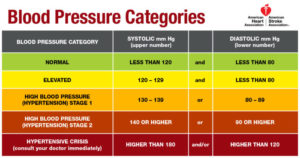Maintaining a healthy blood pressure level is essential to good health. A well-balanced diet and limiting salt intake will help to keep pressure regulated. Managing stress and enjoying regular physical activity will ensure a healthy lifestyle. Our blood pressure chart will help you get on track.
Monitoring blood pressure on a regular basis is essential. Levels could be high, with no symptoms present. Understanding the readings will help in determining if medical attention is necessary. Blood pressure machines are available at local pharmacies and grocery stores. Personal use at-home cuffs are also available for a minimal charge. Keeping accurate records of readings will help to determine if there is a problem.
BLOOD PRESSURE CHART
SYSTOLIC BLOOD PRESSURE:
The upper number of a blood pressure reading is the systolic pressure. The systolic pressure is the amount of pressure put on the artery walls every time the heart beats. Typically, this number rises steadily with age.
- Normal: Less Than 120
- Elevated: 120 – 129
- High Blood Pressure / Stage 1: 130 – 139
- High Blood Pressure / Stage 2: 140 – 180
- Hypertensive Crisis: 180 or higher
DIASTOLIC BLOOD PRESSURE:
The lower number of a blood pressure reading is the diastolic pressure. Diastolic pressure is the amount of pressure put on the artery walls when the heart is resting between beats.
- Normal: Less Than 80
- Elevated: Less Than 80
- High Blood Pressure / Stage 1: 80 – 89
- High Blood Pressure / Stage 2: 90 or higher
- Hypertensive Crisis: 120 or higher
According to the American Health Association blood pressure chart, there are five blood pressure ranges.
NORMAL BLOOD PRESSURE: A normal reading is considered 120/80 mmHg. Anything higher than this should be discussed with a doctor. Regular exercise and a healthy diet will keep this normal level in check.
ELEVATED BLOOD PRESSURE: Elevated blood pressure occurs when levels are consistently ranging from 120-129 systolic and less than 80 mm Hg diastolic. Healthy lifestyle changes should be implemented immediately to reduce the risk of developing hypertension.
HYPERTENSION – STAGE 1: Hypertension occurs when blood pressure is consistently ranging from 130-139 systolic or 80-89 mm Hg diastolic. It is essential to consult with a physician when levels become high. Recommendations for medication and lifestyle changes may be considered.
HYPERTENSION – STAGE 2: Hypertension Stage 2 occurs when blood pressure is consistently ranging at levels of 140/90 mm Hg or higher. At this point, medication will become necessary to lower blood pressure. Changes in diet and exercise will be essential to returning levels to a normal range.
HYPERTENSIVE CRISIS: When blood pressure readings suddenly exceed 180/120 mm Hg, immediate medical attention is required. Symptoms such as chest pain, shortness of breath, back pain, numbness or weakness, change in vision, or difficulty speaking may occur. It’s essential to get blood pressure levels lowered to avoid permanent damage to vital organs.
Understanding how blood pressure affects your body is the key to a healthy lifestyle. Refer back to our blood pressure chart to stay on track.
Medically reviewed by Dr. Susanne Woloson on 5-01-2020.
*Disclaimer: We are a participant in the Amazon Services LLC Associates Program, an affiliate advertising program designed to provide a means for us to earn fees by linking to Amazon.com and affiliated sites.
Read This Next
Maintaining a healthy blood pressure level is essential to good health. A well-balanced diet and limiting salt intake will help to keep pressure regulated. Managing stress...
Read More



